新编简明英语语言学教程第二版课程设计
新编简明英语语言学教程 第二版 戴炜栋11 Second Language Acquisition
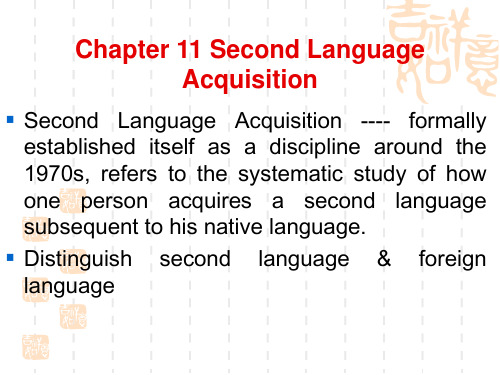
Shortcomings of CA
The CA was soon found problematic, for many of the predictions of the target language learning difficulty formulated on the basis of contrastive analysis turned out to be either uninformative or inaccurate. Predicted errors did not materialize in learner language while errors did show up that the contrastive analysis had not predicted. “Differences” and “difficulties” are not identical concepts.
Characteristics of interlanguage
Interlanguage has three important characteristics: systematicity, permeability 渗透 性 and fossilization. Fossilization---- a process occurring from time to time in which incorrect linguistic features become a permanent part of the way a person speaks or writes a language.
新编简明语言学教程教案第2章

Chapter 2 PhoneticsContents:2.1.The phonic medium of language2.2.1 What is phonetics2.2.2 Organs of speech oral cavitynasal cavitybroad transcription 2.2.3 Orthographic representation of speech soundsnarrow transcriptionvowel2.2.4 Classification of English speech soundsconsonants2.3 phonology2.3.1 phonology and phonetics2.3.2 phone, phoneme, and allophone因素,音位和音位变体2.3.3 phonemic contrast, complementary distribution, and minimal pairSequential rulesAssimilation ruleDeletion rulestress2.3.5 Suprasegmental features toneintonation2.1.The phonic medium of language2.2.1. What is phoneticsPhonetics is defined as the study of the phonic medium of language, it is concerned with all the sounds that occur in the world’s language.语音学是指对语言的语音媒介进行的研究,它关注语言世界中的所有语音。
Articulatory phonetics----it studies how a speaker uses his speech organto articulate the sounds.Acoustic phonetics---- it studies the way sounds travel by looking at thesound waves, the physical means by which soundsare transmitted through the air from one person toanother.发音语音学通过观察声波研究语音的传播方式,即语音经过空气从一个人到达另一个人的物理方式。
新编简明英语语言学教程-第二版-整理
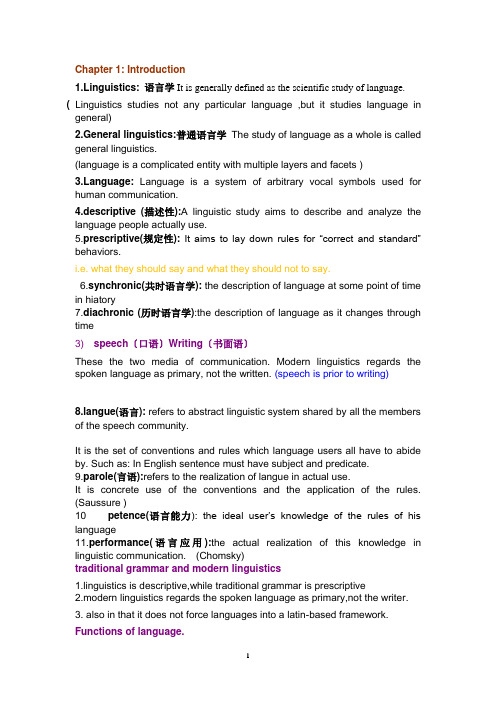
Chapter 1: Introduction1.Linguistics:语言学It is generally defined as the scientific study of language. ( Linguistics studies not any particular language ,but it studies language in general)2.General linguistics:普通语言学The study of language as a whole is called general linguistics.(language is a complicated entity with multiple layers and facets )nguage:Language is a system of arbitrary vocal symbols used for human communication.4.descriptive (描述性):A linguistic study aims to describe and analyze the language people actually use.5.prescriptive(规定性): It aims to lay down rules for “correct and standard” behaviors.i.e. what they should say and what they should not to say.6.synchronic(共时语言学): the description of language at some point of time in hiatory7.diachronic (历时语言学):the description of language as it changes through time3) speech〔口语〕Writing〔书面语〕These the two media of communication. Modern linguistics regards the spoken language as primary, not the written. (speech is prior to writing)ngue(语言): refers to abstract linguistic system shared by all the members of the speech community.It is the set of conventions and rules which language users all have to abide by. Such as: In English sentence must have subject and predicate.9.parole(言语):refers to the realization of langue in actual use.It is concrete use of the conventions and the application of the rules. (Saussure )10 petence(语言能力): the ideal user’s knowledge of the rules of his language11.performance(语言应用):the actual realization of this knowledge in linguistic communication. (Chomsky)traditional grammar and modern linguistics1.linguistics is descriptive,while traditional grammar is prescriptive2.modern linguistics regards the spoken language as primary,not the writer.3. also in that it does not force languages into a latin-based framework. Functions of language.1.the descriptive function.2. the expressive function3.the social functionChapter 2: Phonology音系学phonetics:the study of the phonic medium of language;it is concerned with all the sounds that occur in the world’ s languages9.The three branches of phonetics(1).Articulatory phonetics (发音语音学) (longest history)(2.)Auditory phonetics〔听觉语音学〕(3)Acoustic phonetics (声学语音学〕2. Speech organs: three important areas⑴Pharyngeal cavity咽腔---- the throat;⑵The oral cavity口腔---- the mouth;⑶Nasal cavity –鼻腔--- the nose.The principle source such modifications is the tongue.The tongue is the most flexible.International Phonetic Alphabet [IPA]:the basic principle of the IPA is using one letter selected from major European languages to represent one speech sound.Broad transcription宽式音标. The transcription of speech sounds with letter symbols only.Narrow transcription窄式音标The transcription of speech sound with letters symbols and the diacritics.Aspirated and unaspirated1). phonology: 音系学It aims to discover how speech sounds in a language formpatterns and how these sounds are used to convey meaning in linguistic communication.4. Phone, phoneme, allophoneA phone音素is a phonetic unit or segment.The speech sounds we hear and produce during linguistic communication are all phones. Phones do not necessarily distinguish meaning, some do, some don’t, e.g. [ bI:t ] & [ bIt ], [spIt] & [spIt].A phoneme音位is a phonological unit;it is a unit of distinctive value; an abstract unit, not a particular sound, but it is represented by a certain phone in certain phonetic context, e.g. the phoneme /p/ can be represented differently in [pIt], [tIp] and [spIt].Allophones音素变体---- the phones that can represent a phoneme in different phonetic environmentssequential rule,⑴Sequential rule(序列规则): rule governing the combination of sounds in aparticular language.⑵Assimilation rule〔同化规则〕: rule assimilating one sound to another bycopying features of sequential phoneme,thus making the two phones similar.⑶Deletion rule〔省略规则〕: rule governing the deletion of a sound in acertain phonetic context although it is represented in spelling.6. Suprasegmental features〔超切分特征〕⑴StressWord stress and sentence stress⑵Tone声调Tones are pitch variations,which are caused by the differing rates of vibration of the vocal cords.English is not a tone language, but Chinese is.⑶Intonation语调When pitch, stress and length variations are tied to the sentence rather than to the word, they are collectively known as intonation.English has three types of intonation that are most frequently used:falling tone (matter of fact statement)rising tone (doubts or question)the fall-rise tone (implied message)the frise-fall tone (not frequently used)For instance, “That’s not the book he wants.Chapter 3: Morphology1). Morphology形态学: refers to the the study of the internal structure of wordsand the rules by which words are formed2). Morpheme词素: It is the smallest meaningful unit of language.3). Free morpheme自由词素:a morpheme can be a word by itself.4). Bound morpheme.黏着词素: a morpheme that must be attached to anotherone.5). Allmorphs词素变体:the variant forms of a morphemeChapter 4: SyntaxSyntax句法学: Syntax is a branch of linguistics that studies the rules thatgovern the formation of sentences.Word-level categories1,Major lexical categories2. minor lexical categoriesTo determine a word’s categorie,three critera are usually employed1.meaning2.inflection3.distribution.Phrase:syntactic units that are built around a centain word category complementizers words which introduce the sentence complement complement clause the sentence introduced by the cmomplementizersD-structure:formed by the XP rule in accordance with the head’s subcategorization propertiesS-structure:corresponding to the final syntactic form of the sentence which results form appropriate transformation .Chapter 5: SemanticsSemantics: 语义学can be simply defined as the study of meaning.1)The naming theory(命名论)Oldest notions concering meaning.most primitive one.It was proposed by the ancient Greek scholar Plato.words are just names or labels for things.2〕The conceptualist view〔意念论〕It holds that there is no direct link between a lin-guistic form and what it refers to. In the interpretation of meaning, they are linked through the mediation of concepts in the mind.3)Contextualism〔语境论〕①Meaning should be studied in terms of situation, use, context—elements closely linked with language behavior. Two types of contexts are recognized:②Situational context: spatiotemporal situation③Linguistic context: the probability of a word’s co-occurrence or collocation.④For example, “black” in black hair & black coffee, or black sheep differs in me aning; “The president of the United States” can mean either the president or presidency in different situation.4) Behaviorism〔行为主义论〕Bloomfield①Behaviorists attempted to define meaning as “the situation in which the speaker utters it and the response it calls forth in the hearer”.②The story of Jack and Jill:Jill JackS_________r--------s_________R3. Sense and reference①Sense---- is concerned with the inherent meaning of the linguistic form. It is the collection of all the features of the linguistic form; it is abstract and de-contextualized.②Reference----what a linguistic form refers to in the real, physical world; it deals with the relationship between the linguistic element and the non-linguistic world of experience.4. Major sense relationsSynonymy〔同义关系〕Synonymy refers to the sameness or close similarity of meaning.Words that are close in meaning are called synonyms. 同义词complete synonyms, i.e. synonymy that are mutually substitutable under all circumstances, are rareHomonymy〔同音/同形异义〕Homonymy: Homonymy refers to the phenomenon that words having different meanings have the same form,〔1)Homophones〔同音异义〕: When two words are identical in sound, they are called homophones.e.g. rain/reign.〔2)Homographs(同形异义): When two words are identical in spelling, they are homographs.e.g. tear v. / tear n.〔3)Complete homonyms(同音同形异义):When two words are identical in both sound and spelling, they are called complete homonyms.e.g. fast v. / fast adj.; scale v. /scale. n.Hyponymy〔下义关系〕Hyponymy: Hyponymy refers to the sense relation between a more general, more inclusive word and a more specific word.eg.superordinate: flowerhyponyms: rose, tulip, carnation, lilyAntonymy〔反义关系〕the term antonymy is used for oppositeness of meaning1) Gradable antonyms〔等级反义词〕----there are often intermediate formsbetween the two members of a pair, e.g. old-young, hot-cold, tall-short …2) Complementary antonyms〔互补反义词〕----the denial of one member ofthe pair implies the assertion of the other, e.g. alive-dead, male-female …3) Relational opposites〔关系反义词〕----exhibits the reversal of therelationship between the two items, e.g. husband-wife, father-son, doctor-patient, buy-sell, let-rent, employer-employee, give-receive, above-below …2) There are two aspects to sentence meaning:1.grammatical meaning2. semantic meaning, e.g.selectional restrictions.Whether a sentence is semantically meaningful is governed by ruleseg. constraints on what lexical items can go with what othersPredication analysis---- a way to analyze sentence meaning (B ritish G.Leech).Chapter 6: Pragmatics1). P ragmatics:语用学the study of how speakers of a language use sentences toeffect successful communication.Pragmatics and semantics are both linguistic studies of meaning.What essentially distinguishes semantics and pragmatic s is whether the context of use is considered in the study of meaningIf it is not considered, the study is confined to the area of traditional semantics;if it is considered, the study is being carried out in the area of pragmatics.⑴Austin’s new model of speech actsUtterance meaning:the meaning of an utterance is concrete, and context-dependent. Utterance is based on sentence meaning; it is realization of the abstract meaning of a sentence in a real situation of communication, or simply in a context.Cooperative Principle(CD):Paul Grice.His idea is that to converse with each other, the participants must first of all be willing to cooperate; otherwise, it would not be possible for them to carry on the talk.3〕Principle of conversation (Paul Grice)The maxim of quantity 〔数量准则〕Make your contribution as informative as required (for the current purpose of the exchange). 〔使自己所说的话到达当前交谈目的所要求的详尽程度。
新编简明英语语言学教程_第二版_戴炜栋6_pragmatics课件
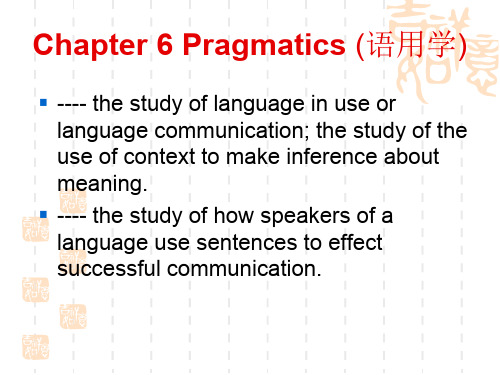
Analyze the illocutionary acts of the following conversation between a couple:
----(the telephone rings)
----H: That’ the phone. (1)
----W: I’m in the bathroom. (2)
---- the study of how speakers of a language use sentences to effect successful communication.
Some basic notions in Pragmatics
Context Pragmatics vs. semantics Sentence meaning vs. utterance meaning Correctness vs. appropriateness
the locutionary act (言内行为) ----an act of saying
something, i.e. an act of making a meaningful utterance (literal meaning of an utterance);
the illocutionary act (言中行为) ----an act performed
Correctness vs. appropriateness
“John play golf”---- grammatically incorrect; “Golf played John” ---- logically incorrect; but it might
be appropriate pragmatically in certain context.
简明新编英语语言学教程教案
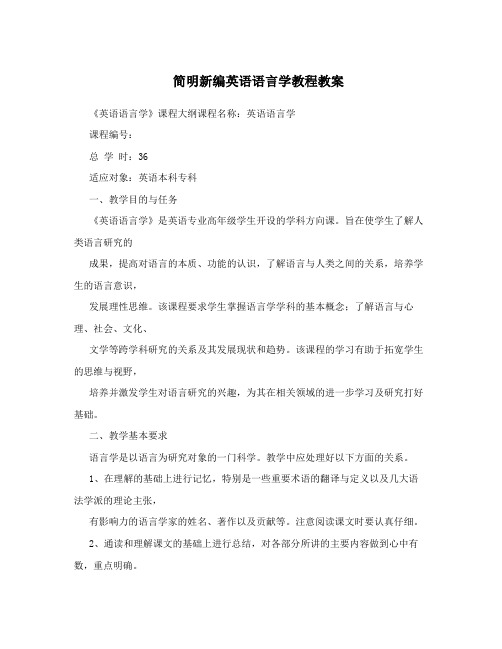
简明新编英语语言学教程教案《英语语言学》课程大纲课程名称:英语语言学课程编号:总学时:36适应对象:英语本科专科一、教学目的与任务《英语语言学》是英语专业高年级学生开设的学科方向课。
旨在使学生了解人类语言研究的成果,提高对语言的本质、功能的认识,了解语言与人类之间的关系,培养学生的语言意识,发展理性思维。
该课程要求学生掌握语言学学科的基本概念;了解语言与心理、社会、文化、文学等跨学科研究的关系及其发展现状和趋势。
该课程的学习有助于拓宽学生的思维与视野,培养并激发学生对语言研究的兴趣,为其在相关领域的进一步学习及研究打好基础。
二、教学基本要求语言学是以语言为研究对象的一门科学。
教学中应处理好以下方面的关系。
1、在理解的基础上进行记忆,特别是一些重要术语的翻译与定义以及几大语法学派的理论主张,有影响力的语言学家的姓名、著作以及贡献等。
注意阅读课文时要认真仔细。
2、通读和理解课文的基础上进行总结,对各部分所讲的主要内容做到心中有数,重点明确。
3、在学习过程中,注意联系、对比,将所学语言学理论与英语外语学习实际相结合。
4、注意提高运用理论解决实际问题的能力。
5、培养学生学术论文写作的能力,建构写作的理论基础及理论依据。
三、教学内容及要求:1.1 为什么学习语言?1.2 什么是语言?1.3 语言的本质特征1.3.1 任意性 arbitrariness1.3.2 二重性 duality1.3.3 创造性 productivity or creativity1.3.4 移位性 displacement1.4 语言的起源1.5 语言的功能1.5.1 信息功能 informative1.5.2 人际功能1.5.3 施为功能1.5.4 感情功能emotive1.5.5 交感性谈话1.5.6 娱乐性功能1.5.7 元语言功能1.6 什么是语言学?1.7 语言学的主要分支1.7.1 语音学phonetics1.7.2 音系学phonlogy1.7.3 形态学mprphology1.7.4 句法学syntax1.7.5 语义学semantics1.7.6 语用学pragmatics1.8 宏观语言学1.8.1 心理语言学1.8.2 社会语言学1.8.3 人类语言学1.8.4 计算语言学1.9 语言学中的一些重要区别1.9.1 “描写式”和“规定式”descriptive and prescriptive 1.9.2 “共时”和“历时”synchronic and diachronic1.9.3 “语言”和“言语”langue and parol1.9.4 语言能力和语言应用competence and performance1.9.5 “非位的”与“位学的”2.1 言语产生和言语感知2.2 言语器官2.3 音段、分化和标音法 2.3.1 音段和分化2.3.2 标音法2.4 辅音2.4.1 辅音和元音2.4.2 辅音2.4.3 发音方法2.4.4 发音部位2.4.5 英语中的辅音2.5 元音2.5.1 元音描写的原则 2.5.2 基本元音理论2.5.3 元音音渡2.5.4 标准发音中的元音2.6 协同发音和语音描写 2.6.1 协同发音2.6.2 宽式标音和严式标音2.7 音位分析2.8 音位和音位变体2.8.1 最小对立体2.8.2 音位理论2.8.3 音位变体2.9 音位过程2.9.1 同化2.9.2 音系过程和音系规则 2.9.3 规则顺序2.10 区别性特征2.11 音节2.11.1 音节结构2.11.2 响音阶2.11.3 音节划分和最大节首原则2.12 重音3.1 什么是词?3.1.1 “词”的三种含义3.1.2 词的识别3.1.3 词的分类3.2 词的形成3.2.1 语素和形态学3.2.2 语素的类型3.2.3 曲折变化和词的形成 3.2.4 音系学和形态学的对立3.3 词汇变化3.3.1 特有的词汇变化 3.3.2 音位变化3.3.3 形态-句法变化3.3.4 语义变化3.3.5 拼写的变化4.1 传统学派4.1.1 数、性、格4.1.2 时和体4.1.3 一致关系和支配关系4.2 结构主义学派4.2.1 组合关系与聚合关系 4.2.2 直接成分分析法 4.2.3 向心结构和离心结构4.3 生成学派4.3.1 深层结构和表层结构 4.3.2 标准理论及其后的发展 4.3.3 管辖、约束等4.4 功能学派4.4.1 功能句子观4.4.2 系统功能语法5.1 “意义”的意义5.2 指称论5.3 涵义关系5.3.1 同义关系5.3.2 反义关系5.3.3 上下义关系5.4 成分分析5.5 句子意义5.5.1 一个整体理论5.5.2 逻辑语义学6.1 言语行为理论 (Speech act theory) 6.1.1 施为句(performatives)和表述句(constatives)6.1.2 行事行为(illocutionary act)理论6.2 会话含义(conversational implicature)理论6.2.1 合作原则6.2.2 准则的违背6.2.3 含义的特征6.3 后格莱斯时期的发展6.3.1 关联理论(relevance theory)6.3.2 数量原则(Q-Principle)和关系原则(R-Principle)6.3.3 数量原则(Q-principle)、信息原则(I-principle)和方式原则(M-principle)四、学时分配与教学方式:总学时:36学时Chapter One: Introduction(6学时)Chapter Two: Phonology (6学时)Chapter Three: Morphology(6学时)Chapter Four: Syntax (6学时)Chapter Five: Semantics (6学时)Chapter Six: Pragmatics(6学时)五、考核方式考查六、本课程与其他课程的关系:英语语言学是专业学生高年级的知识课。
新编简明英语语言学教程 第二版 戴炜栋10 Language Acquisitionppt课件

The innatist view emphasizes more on children’s internal processing of the language items to be learnt. The environment functions as a stimulus that triggers and activates the pre-equipped UG to process the materials provided by the linguistic environment around the children. The interactionist view calls for the quality of the language samples available in the linguistic environment, only when the language is modified and adjusted to the level of children’s comprehension, do they process and internalize the language items.
An innatist view of language acquise innatist view of language acquisition, human beings are biologically programmed for language and that the language develops in the child just as other biological functions such as walking.
新编简明英语语言学教程中文版2

新编简明英语语言学教程中文版2简介《新编简明英语语言学教程中文版2》是一本系统介绍英语语言学的教材。
本教材由专业的语言学家和教育学家编写,旨在帮助学习者深入了解英语语言学的基本概念和原理。
本文档将简要介绍本教材的内容,并对其中重要概念进行概述。
第一章:语言学导论第一章主要介绍了语言学的基本概念和研究对象。
在本章中,学习者将了解什么是语言学,以及语言学的研究范围和方法论。
同时,还提供了一些语言学研究的历史背景和经典理论。
本章的目的是给学习者提供一个全面的语言学导论,为后续章节的学习做好铺垫。
第二章:语音学第二章主要介绍了语音学的基本概念和方法。
学习者将了解语音学的研究对象——音素以及音素的分类和描述方法。
在本章中,还将介绍音系和音位的概念,并讨论语音的产生和感知。
此外,还将讨论音位对语言的重要性以及音系和音位在不同语言间的差异。
通过学习本章内容,学习者将对语音学的基本理论和方法有一个初步了解。
第三章:音系学第三章主要介绍了音系学的研究内容和方法。
在本章中,学习者将学习语音学中的重要概念:音位、语音环境和音变规律。
此外,还将介绍音系学的研究方法,如音位的调查和描述。
通过学习本章内容,学习者将了解音系学在语言研究中的重要性,以及如何通过音系学方法来分析和描述不同语言的音系。
第四章:词汇学第四章主要介绍了词汇学的研究内容和方法。
在本章中,学习者将学习词汇学的基本概念,如词汇的定义和分类。
同时,还将介绍词汇的形态结构和词性。
本章还将介绍词汇的意义和语义关系,并讨论词汇的产生和变化。
通过学习本章内容,学习者将了解词汇学在语言研究中的重要性,以及如何进行词汇的分析和研究。
第五章:句法学第五章主要介绍了句法学的研究内容和方法。
在本章中,学习者将学习句法学的基本概念,如句子的组成和句子的结构。
同时,还将介绍句法分析的方法和理论,如短语结构文法和依存句法。
本章还将讨论句法的意义和句法的变化。
通过学习本章内容,学习者将了解句法学在语言研究中的重要性,以及如何进行句法的分析和研究。
新编简明英语语言学教程 第二版 戴炜栋4 Syntax
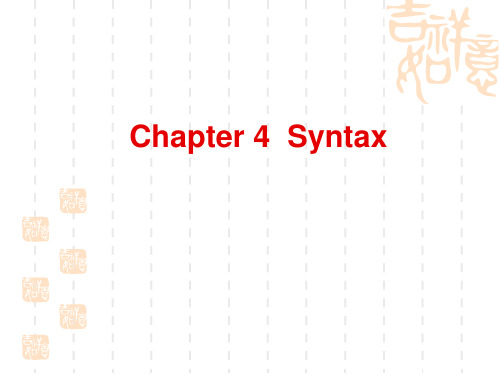
Criteria on good grammar
Observational adequacy Descriptive adequacy Explanatory adequacy The ultimate goal for any theory is to explain. TG differs from traditional grammar in that it not only aims at language description, but also its explanation.
Chapter 4 Syntax
What is syntax?
----a branch of linguistics that studies how words are combined to form sentences and the rules that govern the formation of sentences.
Transformational Generative Grammar (TG) Norm. Chomsky, the most influential linguist in 20th century, some important works: (1957) Syntactic Structure; (1965) Aspects of the Theory of Syntax; (1981) Lectures on Government and Binding; (1986) Barriers (1993) A Minimalist Program for Linguistic Theory; (1995) The Minimalist Program; (1998) The Minimalist Inquiry……
戴炜栋《新编简明英语语言学教程》(第2版)笔记和课后习题考研真题
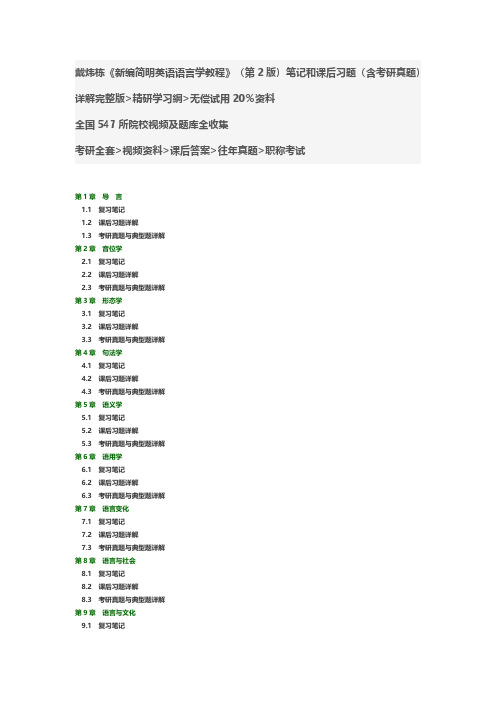
戴炜栋《新编简明英语语言学教程》(第2版)笔记和课后习题(含考研真题)详解完整版>精研学习䋞>无偿试用20%资料
全国547所院校视频及题库全收集
考研全套>视频资料>课后答案>往年真题>职称考试
第1章导言
1.1复习笔记
1.2课后习题详解
1.3考研真题与典型题详解
第2章音位学
2.1复习笔记
2.2课后习题详解
2.3考研真题与典型题详解
第3章形态学
3.1复习笔记
3.2课后习题详解
3.3考研真题与典型题详解
第4章句法学
4.1复习笔记
4.2课后习题详解
4.3考研真题与典型题详解
第5章语义学
5.1复习笔记
5.2课后习题详解
5.3考研真题与典型题详解
第6章语用学
6.1复习笔记
6.2课后习题详解
6.3考研真题与典型题详解
第7章语言变化
7.1复习笔记
7.2课后习题详解
7.3考研真题与典型题详解
第8章语言与社会
8.1复习笔记
8.2课后习题详解
8.3考研真题与典型题详解
第9章语言与文化
9.1复习笔记
9.2课后习题详解
9.3考研真题与典型题详解第10章语言习得
10.1复习笔记
10.2课后习题详解
10.3考研真题与典型题详解第11章第二语言习得
11.1复习笔记
11.2课后习题详解
11.3考研真题与典型题详解第12章语言与大脑
12.1复习笔记
12.2课后习题详解
12.3考研真题与典型题详解。
新编简明英语语言学教程 第二版 戴炜栋9 Language and Culture课件

PPT学习交流
10
The significance of cultural teaching and learning
• Learning a foreign language is inseparable from learning its culture.
• We need to learn enough about the language’s culture so that we can communicate in the target language
PPT学习交流
5
Two Interpretations about SWH
• Strong version believes that the language patterns determine people’s thinking and behavior;
• Weak version holds that the former influence the latter.
----The study of the linguistic relativity or SWH has shed two important insights (领悟) :
• There is nowadays a recognition that language, as code, reflects cultural preoccupations (偏见,成见) and constrains the way people think.
roadside…(B3 L10 Diogenes and Alexander)
PPT学习交流
9
to die --- to pass away; to depart; to go to sleep; to go to heaven
(NEW)戴炜栋《新编简明英语语言学教程》(第2版)笔记和课后习题(含考研真题)详解
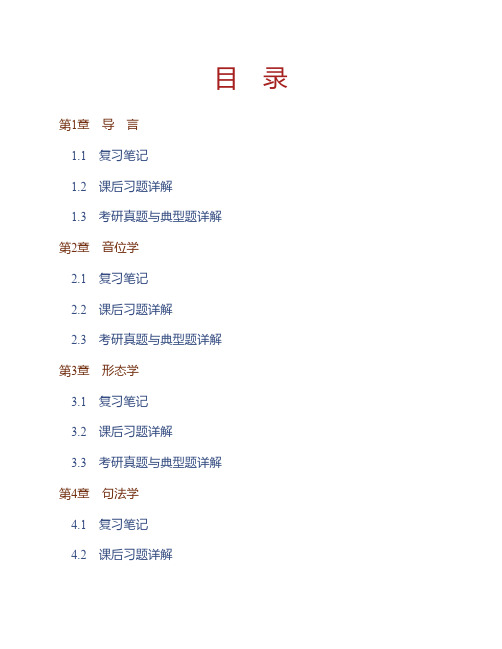
目 录第1章 导 言1.1 复习笔记1.2 课后习题详解1.3 考研真题与典型题详解第2章 音位学2.1 复习笔记2.2 课后习题详解2.3 考研真题与典型题详解第3章 形态学3.1 复习笔记3.2 课后习题详解3.3 考研真题与典型题详解第4章 句法学4.1 复习笔记4.2 课后习题详解4.3 考研真题与典型题详解第5章 语义学5.1 复习笔记5.2 课后习题详解5.3 考研真题与典型题详解第6章 语用学6.1 复习笔记6.2 课后习题详解6.3 考研真题与典型题详解第7章 语言变化7.1 复习笔记7.2 课后习题详解7.3 考研真题与典型题详解第8章 语言与社会8.1 复习笔记8.2 课后习题详解8.3 考研真题与典型题详解第9章 语言与文化9.1 复习笔记9.2 课后习题详解9.3 考研真题与典型题详解第10章 语言习得10.1 复习笔记10.2 课后习题详解10.3 考研真题与典型题详解第11章 第二语言习得11.1 复习笔记11.2 课后习题详解11.3 考研真题与典型题详解第12章 语言与大脑12.1 复习笔记12.2 课后习题详解12.3 考研真题与典型题详解第1章 导 言1.1 复习笔记本章要点:1. The definition and main branches of linguistics study语言学的定义和研究的范围2. Important distinctions in Linguistics语言学的一些重要区分3. The definition and the design features of language语言的定义与识别特征4. Functions of language语言的功能本章考点:1. 有关语言学的常考考点语言学的定义;语言学中几组重要区别,每组两个概念的含义、区分及其意义;普通语言学的主要分支学科及各自的研究范畴;宏观语言学及应用语言学的主要分支及各自的研究范畴。
英语简明语言学课程设计
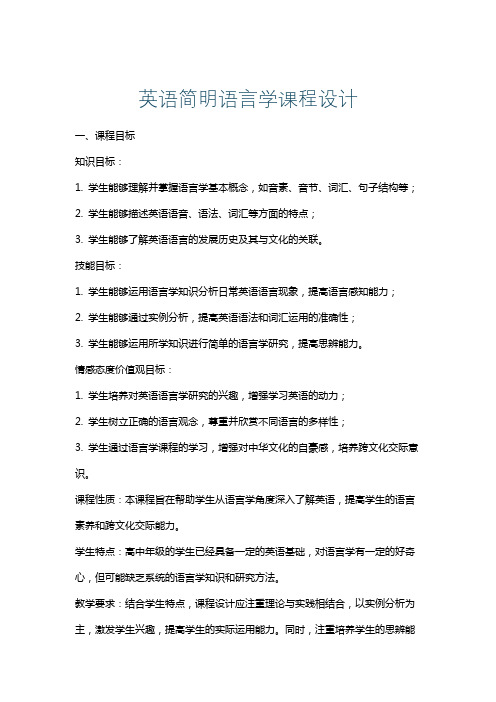
英语简明语言学课程设计一、课程目标知识目标:1. 学生能够理解并掌握语言学基本概念,如音素、音节、词汇、句子结构等;2. 学生能够描述英语语音、语法、词汇等方面的特点;3. 学生能够了解英语语言的发展历史及其与文化的关联。
技能目标:1. 学生能够运用语言学知识分析日常英语语言现象,提高语言感知能力;2. 学生能够通过实例分析,提高英语语法和词汇运用的准确性;3. 学生能够运用所学知识进行简单的语言学研究,提高思辨能力。
情感态度价值观目标:1. 学生培养对英语语言学研究的兴趣,增强学习英语的动力;2. 学生树立正确的语言观念,尊重并欣赏不同语言的多样性;3. 学生通过语言学课程的学习,增强对中华文化的自豪感,培养跨文化交际意识。
课程性质:本课程旨在帮助学生从语言学角度深入了解英语,提高学生的语言素养和跨文化交际能力。
学生特点:高中年级的学生已经具备一定的英语基础,对语言学有一定的好奇心,但可能缺乏系统的语言学知识和研究方法。
教学要求:结合学生特点,课程设计应注重理论与实践相结合,以实例分析为主,激发学生兴趣,提高学生的实际运用能力。
同时,注重培养学生的思辨能力和跨文化交际意识。
通过具体的学习成果评估,确保课程目标的实现。
二、教学内容1. 语言学基本概念:音素、音节、词汇、句子结构等;教材章节:第一章 语言与语言学2. 英语语音特点:音标、发音规则、连读、语调等;教材章节:第二章 英语语音3. 英语语法结构:词类、句型、时态、语态等;教材章节:第三章 英语语法4. 英语词汇特点:词义、词性、词汇搭配、词源等;教材章节:第四章 英语词汇5. 语言与文化:英语国家文化背景、交际礼仪、跨文化交际等;教材章节:第五章 语言与文化6. 语言学研究方法:观察、实证研究、案例分析等;教材章节:第六章 语言学与语言研究教学内容安排与进度:第一周:语言学基本概念第二周:英语语音特点第三周:英语语法结构第四周:英语词汇特点第五周:语言与文化第六周:语言学研究方法三、教学方法本课程将采用以下多样化的教学方法,以激发学生的学习兴趣和主动性:1. 讲授法:针对语言学基本概念、语法结构等理论性较强的内容,通过教师系统、清晰的讲解,帮助学生建立扎实的理论基础。
新编简明英语语言学教程 第二版 戴炜栋11 Second Language Acquisition

Overgeneralization
Overgeneralization ---- the use of previously available strategies in new situations. Walked, watched, washed… *rided, *goed, *doed, *eated… Jane advised me to give up smoking. Jane told me to give up smoking. *Jane hoped me to give up smoking. *Jane suggested me to give up smoking.
Interlanguage (S. Pit Corder & Larry Selinker) Interlanguage ---- learners’ independent system of the second language which is of neither the native language nor the second language, but a continuum or approximation from his native language to the target language. What learners produce, correct or wrong, are evidence or the approximation from their first language to the target language.
Connections
between first language acquisition & second language acquisition
简明新编英语语言学教程教案
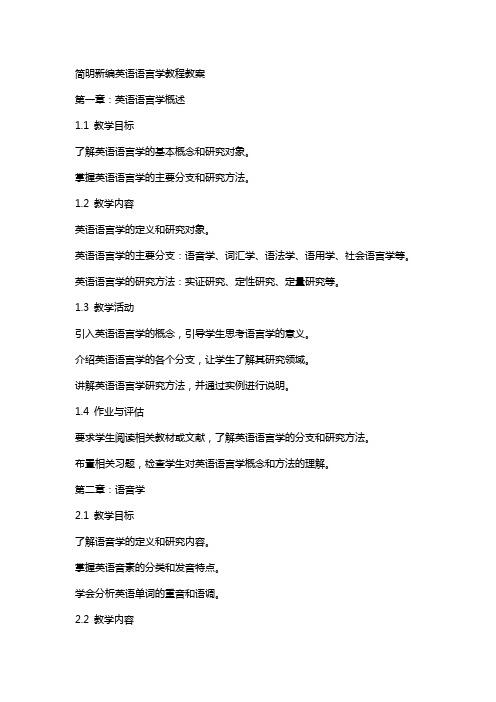
简明新编英语语言学教程教案第一章:英语语言学概述1.1 教学目标了解英语语言学的基本概念和研究对象。
掌握英语语言学的主要分支和研究方法。
1.2 教学内容英语语言学的定义和研究对象。
英语语言学的主要分支:语音学、词汇学、语法学、语用学、社会语言学等。
英语语言学的研究方法:实证研究、定性研究、定量研究等。
1.3 教学活动引入英语语言学的概念,引导学生思考语言学的意义。
介绍英语语言学的各个分支,让学生了解其研究领域。
讲解英语语言学研究方法,并通过实例进行说明。
1.4 作业与评估要求学生阅读相关教材或文献,了解英语语言学的分支和研究方法。
布置相关习题,检查学生对英语语言学概念和方法的理解。
第二章:语音学2.1 教学目标了解语音学的定义和研究内容。
掌握英语音素的分类和发音特点。
学会分析英语单词的重音和语调。
2.2 教学内容语音学的定义和研究内容。
英语音素的分类:元音、辅音、半元音等。
英语单词的重音和语调。
2.3 教学活动引入语音学的概念,引导学生了解其重要性。
讲解英语音素的分类和发音特点,通过示例进行演示。
分析英语单词的重音和语调,让学生进行实践。
2.4 作业与评估要求学生阅读相关教材或文献,了解语音学的相关知识。
布置相关习题,检查学生对英语音素分类和发音特点的理解。
让学生录制英语单词的重音和语调,进行自我评估。
第三章:词汇学3.1 教学目标了解词汇学的定义和研究内容。
掌握英语词汇的分类和构成方式。
学会分析英语词汇的语义关系和语用功能。
3.2 教学内容词汇学的定义和研究内容。
英语词汇的分类:名词、动词、形容词等。
英语词汇的构成方式:派生、合成、转化等。
英语词汇的语义关系和语用功能。
3.3 教学活动引入词汇学的概念,引导学生了解其重要性。
讲解英语词汇的分类和构成方式,通过示例进行演示。
分析英语词汇的语义关系和语用功能,让学生进行实践。
3.4 作业与评估要求学生阅读相关教材或文献,了解词汇学的相关知识。
布置相关习题,检查学生对英语词汇分类和构成方式的理解。
新编简明英语语言学教程 第二版 戴炜栋11 Second Language Acquisition(课堂PPT)
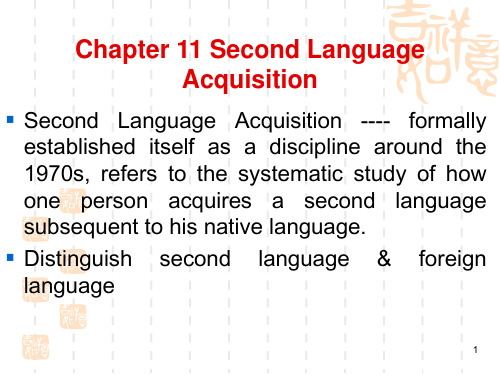
Mentalists (心灵主义者) argued that few errors were
caused by language transfer; transfer is not transfer,
but a kind of mental process.
13
2nd language learning models and
4
Error analysis (EA)
▪ The contrastive approach to learners’ errors has shed new light on people’s attitudes: the errors are significant in telling the teacher what needs to be taught, in telling the researcher how learning proceeds and those errors are a means whereby learners test their hypotheses about the language to be learnt.
▪ *To touch the society .
▪ *There are more people come to study in the states.
▪ *I wait you at the gate of the school.
3
Shortcomings of CA
▪ The CA was soon found problematic, for many of the predictions of the target language learning difficulty formulated on the basis of contrastive analysis turned out to be either uninformative or inaccurate. Predicted errors did not materialize in learner language while errors did show up that the contrastive analysis had not predicted. “Differences” and “difficulties” are not identical concepts.
- 1、下载文档前请自行甄别文档内容的完整性,平台不提供额外的编辑、内容补充、找答案等附加服务。
- 2、"仅部分预览"的文档,不可在线预览部分如存在完整性等问题,可反馈申请退款(可完整预览的文档不适用该条件!)。
- 3、如文档侵犯您的权益,请联系客服反馈,我们会尽快为您处理(人工客服工作时间:9:00-18:30)。
新编简明英语语言学教程第二版课程设计
1. 课程背景与目标
英语作为全球通用的语言之一,在全球范围内都广泛应用。
掌握英语语言学知识,有助于提高人们的英语水平,建立坚实的英语语言基础,更好地适应国际化发展的需要。
本课程旨在通过深入浅出的教学方式,帮助学生更好地掌握英语语言学的基本知识,提高英语语言能力和语言思维能力。
2. 课程设置
2.1 课程名称
新编简明英语语言学教程第二版
2.2 课程学时
本课程为学期课程,总学时为48学时。
每周2学时。
2.3 课程内容
本课程的主要内容包括:
•语音学:英语语音的基本概念和理论,音位、音素、音节的基本单位和特征等。
•词汇学:英语词汇的基本概念和分类,词义、词源、词形变化等。
•句法学:英语句子的基本成分和结构,句子类型、语法关系等。
•语义学:英语语义的基本概念,意义的表示和匹配等。
•话语分析:英语话语的类型、结构和功能,语用学的基本原理等。
2.4 课程教材
•教材:《新编简明英语语言学教程(第二版)》(张三主编,出版社,2021)
•辅助教材:《英语语音学教程》(李四著,出版社,2021)、《英语词汇学教程》(王五著,出版社,2021)
2.5 课程方法
本课程采用讲授、课堂讨论、小组研讨等方式进行教学。
以问题为核心,以学生为主体,深入浅出地介绍语音学、词汇学、句法学、语义学和话语分析等方面的基本概念和理论,帮助学生掌握英语语言学的核心知识和方法,提高英语语言能力和语言思维能力。
3. 课程评估
3.1 课程作业
本课程的作业包括:
•课堂笔记:学生对每堂课上的重要内容进行记录,总结、归纳并反思自己的收获;
•课外阅读:学生选择相关教材或者资料,深入研究课程内容,自己探索问题;
•小组研讨:学生自行组织小组,开展研讨活动,以小组报告的形式汇报整理的成果。
3.2 课程考核
本课程考核方式采取闭卷考试和开卷论文两种形式,占比各50%。
•闭卷考试:所考考试内容以教学大纲为基础,涵盖课程的重点内容和难点问题,考察学生对于英语语言学基本概念的掌握和应用。
•开卷论文:论文题目从课程内容中自选,并与教师进行讲解和分析,涵盖英语语音学、词汇学、句法学、语义学和话语分析等方面的内容。
4. 课程总结
本课程旨在通过深入浅出的教学方式,帮助学生更好地掌握英语语言学的基本知识,提高英语语言能力和语言思维能力。
通过学习本课程,学生将深入了解英语语言的基本特征和结构,理解语音、词汇、句法、语义和话语分析等方面的基本概念和理论,从而为进一步提高英语水平、探究英语语言本质、拓展国际交流拓展视野等方面奠定坚实的基础。
